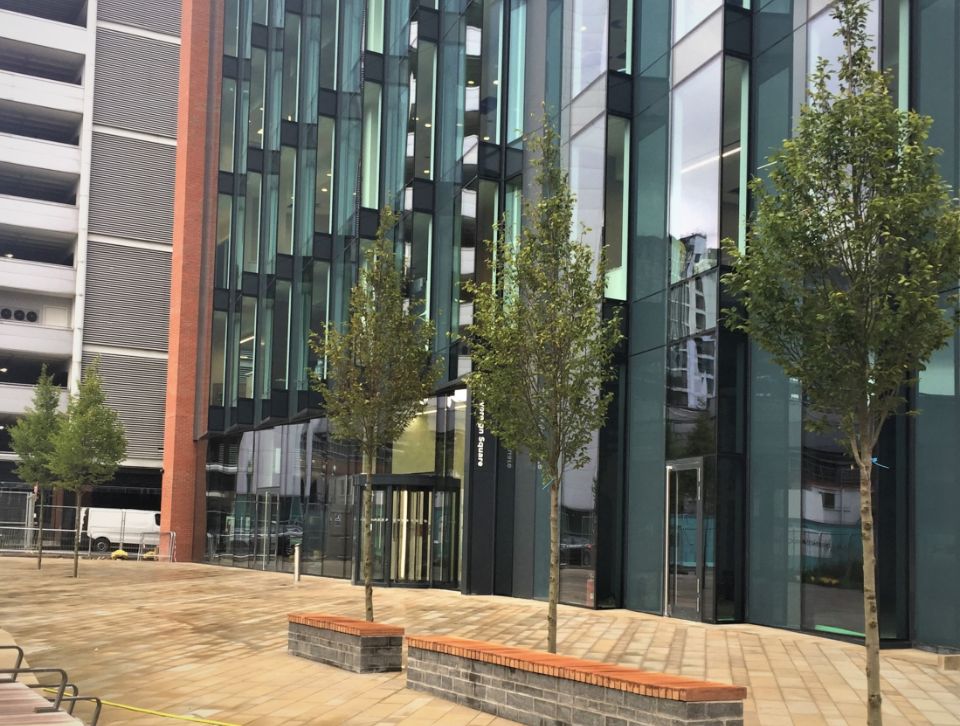Silva Cells were installed in the multi-phase renovation project, providing soil volume to trees along the circular pathway around the new retail, dining, and residential development

First opened in 1933, the Battersea Power Station — with its distinctive four chimney-stack architecture — is an icon of the London cityscape, hugging the south bank of the River Thames in the Wandsworth community for ninety years. Officially decommissioned since the early 1980s, numerous revitalization plans fell through the cracks until, in 2012, a partnership of Malaysian investors spearheaded a new development of housing, shopping, and dining — a brand new, award-winning Battersea Station, opening to the public in October 2022. The landscaping component of the project was led by LDA Design, who envisioned a pedestrian-friendly exterior walkway and gathering space lined with trees. The Silva Cell system was installed in numerous phases, creating a complete “halo” circle of footpaths and trees surrounding the Battersea Station and providing lightly compacted soil for healthy tree growth.
Number of Silva Cells: 390 (2x) and 48 (1x)
Amount of Soil Volume Per Tree: 13m3
Number of Trees: 77
Type of Project: Streetscape, Plaza
Project Designer: LDA Design
Project Contractor: Keltbray, Maylim Limited
Installation Date of Silva Cells: 2017-2022

Photo courtesy of Wikimedia

Designed by renowned architect Giles Gilbert Scott, Battersea Power Station was officially commissioned in 1933 (with a second, adjacent station — “B” — opened twenty years later). Positioned along the southern side of the Thames in Wandsworth, the coal- and oil-firing facilities provided, at their peak output, one-fifth of all power used by Londoners. The structure itself is an icon of the river skyline, with its recognizable quad-chimney façade featured in numerous entertainment outlets — from Pink Floyd’s “Animals” album cover to the 2008 Batman film, The Dark Knight.
In 1975, the original station closed its doors; five years later, the building was given a Grade II “Listed Status,” which was quickly followed, in 1983, by the decommissioning of Station B. What to do with the idle structure (and its newly protected status, making its demolition extraordinarily difficult) vexed the community for decades. A handful of optimistic, though ultimately futile, redevelopment plans were discussed — including one scheme to create an indoor amusement park. Finally, in 2012, after a partnership with Malaysian investors, a real, fully funded renovation was initiated.

The £9 billion project, as identified by the architects at Wilkinson Eyre, sought to retain “the Power Station’s sense of scale and visual drama” in the redevelopment. While maintaining the grandness of the original design, the modernized Battersea Station would be a mixed-use development featuring retail, dining, and housing both within the station and in the new adjacent residential complexes.
As cited by Battersea’s website, the “building is [now] home to Apple’s London Campus, hundreds of new shops housed in the historic turbines halls, a state-of-the-art dolby cinema, a 24,000 square-foot food hall, a glass chimney lift and hundreds of new homes.”
In the 42-acre area, developers also incorporated 19 acres of new public space — and planning for the exterior landscaping was led by the team at LDA Design. Exterior Architecture notes that “the design includes all public realms spaces that are situated around two new residential buildings, including a new walk adjacent to the Thames, residential gardens located on podiums and the creation of the ‘Halo’ around the power station.”

This “halo” was to feature a closed circle of trees planted in the new footpaths — a project uniquely suited to the Silva Cell system.
A total of 438 Silva Cells, both 1x and 2x configurations, were installed in phases between 2017 and 2022. More than 70 trees are each accessing 13 cubic meters of soil volume for healthy root expansion and thus continued growth and vitality in the coming years. The trees are already contributing to the welcoming ambiance of the new development, which LDA Design wanted to ensure “soften[ed] the monumental scale of the Power Station.” As the team likewise noted: “If a new landscape works, it feels it has always been there.”
-2023 Developer of the Year (Commercial Property) – Property Awards
-2023 Royal Academy of Engineering’s Major Project Award for Sustainability
-2023 Development of the Year – Resi Awards
For other DeepRoot projects in the UK, check out our case studies here, here, and here.

